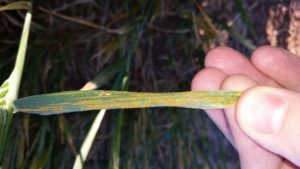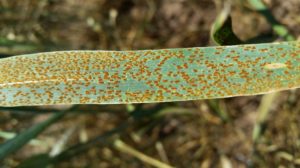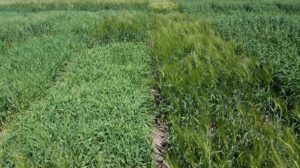by Dr. Clark Neely, Statewide Small Grains Extension Specialist, Texas A&M AgriLife Extension, College Station, TX, Dr. Ron French, Extension Plant Pathologist, Texas A&M AgriLife Extension, Amarillo, TX,
Dr. Josh McGinty, Regional Extension Agronomist, Texas A&M AgriLife Extension, Corpus Christi, TX

Figure 1. Stripe rust can devastate wheat yields if left untreated (Texas A&M AgriLife Extension photo by Dr. Clark Neely).
Wheat rusts have been another hot topic in wheat production for 2016. Following a severe stripe rust outbreak in 2015, most of Texas is once again seeing the effects of this disease on the state’s crop for 2016 (Fig 1). Mild winter temperatures allowed for the establishment and early onset of stripe rust in northern Texas as well as in many parts of the Southern Great Plains. Wet conditions then encouraged rapid development and spread of stripe rust across the region. Even portions of the High Plains saw stripe rust again this year, though not as severe as in 2015. Leaf rust (Fig 2) is also present and gaining momentum as temperatures warm, but its presence is currently low to moderate in most cases and the crop is advanced enough in growth that infection should have minimal impact on yield.

Figure 2. Leaf rust can significantly reduce wheat yields if left untreated (Texas A&M AgriLife Extension photo by Dr. Clark Neely).
The first line of defense against rust of any kind is provided by the rust resistance of the wheat variety. If stripe rust pressure is heavy and infection occurs early in the year, even resistant varieties can lose considerable yield; however, under these conditions as much as 25% yield losses are possible instead of the potential 85% loss with susceptible varieties. While resistance is not completely foolproof, it does provide a significant level of protection for your crop, especially if the disease goes undetected or fungicide applications are delayed.
Fungicides are another excellent tool that can be used to manage rusts in wheat and other small grains. Triazole and strobilurin containing products are both effective at managing rust, but act in different ways against the rust pathogen. Triazoles only target actively growing rust cells, but do not impact spores. These products typically only provide two to three weeks of protection. In contrast, strobilurin products disrupt energy production within cells and therefore control rust spores. These products last slightly longer than triazoles, from three to four weeks at most. Many fungicides include both modes of action to provide both a curative (triazole) and preventative (strobilurin) action against the disease. More information on variety resistance, rust identification and management, and labelled fungicides can be found at http://varietytesting.tamu.edu/wheat or http://amarillo.tamu.edu/amarillo-center-programs/extension-plant-pathology/. Producers should keep in mind that in many cases wheat has already passed the approved application window. Most fungicides are only labeled for application through heading and at most flowering, with pre harvest intervals of 30-45 days in most cases.

Figure 3. Mild winter temperatures led to vernalization problems in South and Central Texas winter wheat. A vernalized wheat is fully headed on the right while a veriety with a longer chilling requirement did not vernalize on left. Photo was taken in Thrall, TX on April 5, 2016 (Texas A&M AgriLife Extension photo by Dr. Clark Neely).
Besides disease, mild winter temperatures led to vernalization issues of winter wheat in some areas of Texas (Fig 3). Vernalization refers to the period of cold temperatures required for winter wheat to switch from vegetative growth to reproductive growth. Without it, winter wheat will not produce a seed head. Vernalization requirements range drastically among winter wheat varieties from 120 up to 1080 hours below 45oF. South Texas was most affected with many varieties planted in the region that reportedly did not fully vernalize. Some varieties did vernalize, but were significantly delayed in maturity. In areas south of San Antonio and along the Gulf Coast, spring wheats are recommended because they do not need to vernalize and mature according to heat units only. In south Texas, spring wheats should be planted in December, roughly three to four weeks after winter wheat in order to achieve a comparable harvest date.
Wheat harvest has already begun in portions of South Texas, however, wet field conditions will likely delay harvest in many fields. If wet weather continues, wheat yield and quality may begin to decline if producers cannot harvest in a timely manner.

Clark Neely
State Small Grains Agronomist
College Station, TX
cbneely@tamu.edu